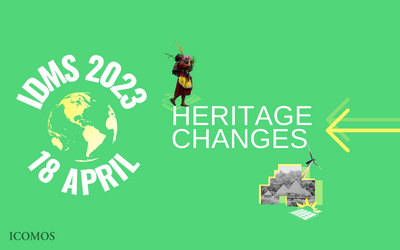IDMS 2023: Heritage Changes in five publications
 For the 2023 edition of the International Day for Monuments and Sites, the Documentation Centre has selected five publications from the ICOMOS Open Archive in keeping with the theme Heritage Changes.
For the 2023 edition of the International Day for Monuments and Sites, the Documentation Centre has selected five publications from the ICOMOS Open Archive in keeping with the theme Heritage Changes.
Exploring and discussing the impact of climate change on cultural heritage sites and landscapes through a variety of approaches, they highlight the need to protect and promote the resilience of cultural heritage by providing practical guidance and recommendations for policy makers, heritage practitioners and local communities.
|
Integration of climate action and the Sustainable Development Goals in World Heritage sites. Lydia Loopesko, Gabriel Victor Caballero. ICOMOS Sustainable Development Goals Working Group, 2021. [English] How can World Heritage Sites be used as a framework to achieve the 17 Sustainable Development Goals (SDGs), with climate action as a significant factor? This research examines four World Heritage Sites and evaluates their implementation of climate action and the SDGs, concluding that leadership and governance are essential for achieving sustainable development.
|
|
|
|
This reports commissioned by the Heritage Council and ICOMOS Ireland reviews the current state of knowledge and risks relating to the deep energy renovation of traditional buildings, which have different hygroscopic and thermal behaviours than modern buildings. An annotated bibliography assembles a list of the statutes, standards, technical documents, academic research, and case studies relevant to deep energy renovation works in traditional buildings in Ireland, to help building practitioners with the resources and tools to overcome knowledge gaps in practice.
|
|
This report of the VerSus project focuses on the analysis of vernacular heritage in Portugal, Spain, Italy, and France, with the aim to apply its contribution to sustainable architecture. The project has collected a series of images that illustrate fifteen principles and over one hundred environmental, socio-cultural, and socio-economic sustainable strategies. These principles and strategies are then applied to recent projects in each country to inspire architects and project designers to incorporate these sustainable strategies into their designs.
|
|
This book presents a new approach to the preservation of historic timber structures based on the Principles for the Preservation of Historic Timber Structures adopted by ICOMOS. It provides an ecological and environmentally responsible guide to preservation, founded on respect for traditional crafts and building traditions. The authors emphasize the importance of preserving the craft techniques and knowledge involved in the construction of timber structures, as they are integral to the preservation of the structures themselves.
|


 Cultural landscapes under the threat of climate change: a systematic study of barriers to resilience. Gül Aktürk, Ahmadreza Shirvani Dastgerdi, Ahmadreza Shirvani. Sustainability, 13 (17, 99). Basel (Switzerland): MDPI, 2021. ISSN 2071-1050 [English]
Cultural landscapes under the threat of climate change: a systematic study of barriers to resilience. Gül Aktürk, Ahmadreza Shirvani Dastgerdi, Ahmadreza Shirvani. Sustainability, 13 (17, 99). Basel (Switzerland): MDPI, 2021. ISSN 2071-1050 [English] Deep energy renovation of traditional buildings: addressing knowledge gaps and skills training in Ireland. Caroline Engel Purcell. Kilkenny (Ireland): Heritage Council, 2018. 154 p. [English]
Deep energy renovation of traditional buildings: addressing knowledge gaps and skills training in Ireland. Caroline Engel Purcell. Kilkenny (Ireland): Heritage Council, 2018. 154 p. [English] VerSus: lessons from vernacular heritage to sustainable architecture. Hubert Guillaud (ed.). Grenoble (France): CRAterre éditions, 2014. 74 p. ISBN 978-2-906901-78-0 [English]
VerSus: lessons from vernacular heritage to sustainable architecture. Hubert Guillaud (ed.). Grenoble (France): CRAterre éditions, 2014. 74 p. ISBN 978-2-906901-78-0 [English] Conservation of historic timber structures: an ecological approach. Knut Einar Larsen, Nils Marstein. Oxford (United Kingdom): Butterworth-Heinemann, 2000 & Oslo (Norway): self-published, 2016. 140 p. [English]
Conservation of historic timber structures: an ecological approach. Knut Einar Larsen, Nils Marstein. Oxford (United Kingdom): Butterworth-Heinemann, 2000 & Oslo (Norway): self-published, 2016. 140 p. [English]